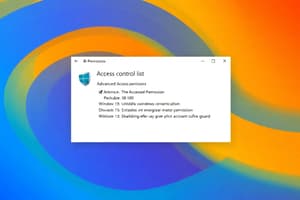Podcast
Questions and Answers
What is the purpose of the given configuration 'access-list 1 permit 192.168.1.0 0.0.0.255'?
What is the purpose of the given configuration 'access-list 1 permit 192.168.1.0 0.0.0.255'?
- Deny Telnet traffic from 192.168.1.0 network
- Allow Telnet traffic from 192.168.1.0 network (correct)
- Deny Telnet traffic to 192.168.1.0 network
- Allow Telnet traffic to 192.168.1.0 network
Why is it advisable to apply standard access lists as close to the destination as possible?
Why is it advisable to apply standard access lists as close to the destination as possible?
- To reduce processing load on intermediate routers
- To improve security by filtering traffic early in the network flow (correct)
- To prevent IP address spoofing
- To prioritize certain types of traffic
In the given context, what would be the effect of changing 'permit' to 'deny' in the ACL statement?
In the given context, what would be the effect of changing 'permit' to 'deny' in the ACL statement?
- Block Telnet traffic from all networks except 192.168.1.0 (correct)
- Allow Telnet traffic from all networks except 192.168.1.0
- Allow Telnet traffic only from 192.168.1.0
- Block Telnet traffic from 192.168.1.0 network
What is the significance of naming access lists instead of using numbers?
What is the significance of naming access lists instead of using numbers?
How does applying an ACL on a VTY line differ from applying it on an interface?
How does applying an ACL on a VTY line differ from applying it on an interface?
What is a key advantage of using named access lists over numbered access lists?
What is a key advantage of using named access lists over numbered access lists?
If an explicit deny statement is not included in an extended access list, what will be the default action for traffic not explicitly permitted?
If an explicit deny statement is not included in an extended access list, what will be the default action for traffic not explicitly permitted?
'Access-class 1 in' is applied on which interface line in the provided configuration?
'Access-class 1 in' is applied on which interface line in the provided configuration?
'Operators eq (equal to), neq (not equal to), lt (less than), gt (greater than)' are used for what purpose in ACLs?
'Operators eq (equal to), neq (not equal to), lt (less than), gt (greater than)' are used for what purpose in ACLs?
What is a major advantage of using named access lists over numbered access lists?
What is a major advantage of using named access lists over numbered access lists?
Flashcards are hidden until you start studying
Study Notes
Access Control Lists (ACLs)
- Access Control Lists (ACLs) are used to filter traffic based on various criteria such as source, destination, protocol, and port number.
Standard Access Lists (SALs)
- SALs have a number range of 1-99.
- They can block a network, host, or subnet.
- They can only block or permit all traffic (two-way communication).
- They are implemented closest to the destination.
- Filtering is done based on only the source IP address.
Extended Access Lists (EALs)
- EALs have a number range of 100-199.
- They can block a network, host, subnet, or service.
- They can block or permit specific services (one-way communication).
- They are implemented closest to the source.
- They check source, destination, protocol, and port number.
Named Access Lists (NALs)
- NALs can be edited.
- They can be used to block specific traffic.
- They can be applied to an interface in either direction (inbound or outbound).
HSRP (Hot Standby Router Protocol)
- HSRP is a solution to traffic shifting issues.
- It generates a virtual gateway with a different IP address.
- It becomes the gateway for all hosts.
Access List Configuration
- Standard Access List creation:
Router(config)#ip access-list standard - Extended Access List creation:
Router(config)#ip access-list extended - Applying an Access List to an interface:
Router(config)#interfaceandRouter(config-if)#ip access-group
Example of Access List Configuration
- Blocking HTTP traffic from 192.168.1.2 to 192.168.2.2:
R1(config)#access-list 100 deny tcp host 192.168.1.2 host 192.168.2.2 eq 80 - Blocking FTP traffic from 192.168.1.0 to 192.168.2.2:
R1(config)#access-list 100 deny tcp 192.168.1.0 0.0.0.255 host 192.168.2.2 eq 21 - Blocking ICMP traffic from 192.168.1.0 to 192.168.2.3:
R1(config)#access-list 100 deny icmp 192.168.1.0 0.0.0.255 host 192.168.2.3 echo
Editing and Removing Access List Entries
- Editing a Named Access List:
R1(config)#ip access-list extended ABC - Removing an Access List entry:
R1(config)#ip access-list extended ABCandR1(config-ext-nacl)#no 50 deny icmp 192.168.1.0 0.0.0.255 host 192.168.2.3 echo-reply
Studying That Suits You
Use AI to generate personalized quizzes and flashcards to suit your learning preferences.




